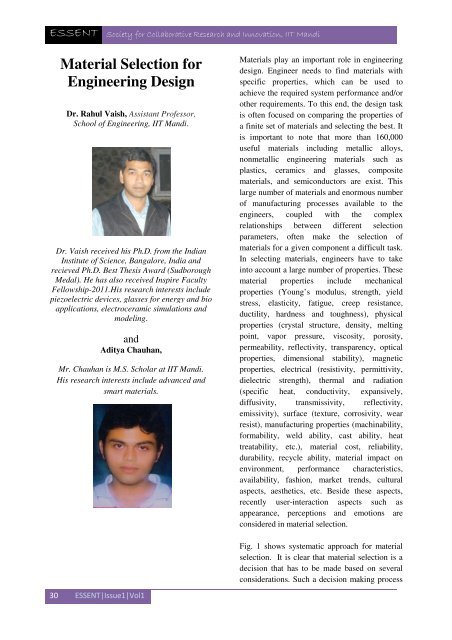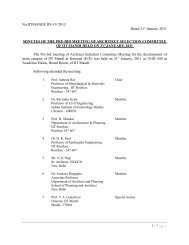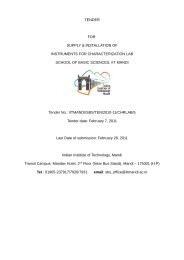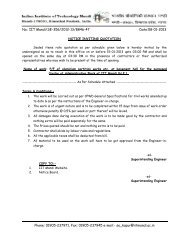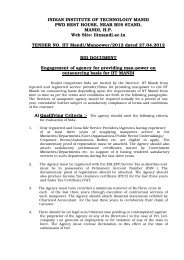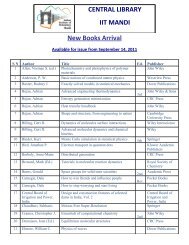Issue1. Vol.1 (April, 2013) - IIT Mandi
Issue1. Vol.1 (April, 2013) - IIT Mandi
Issue1. Vol.1 (April, 2013) - IIT Mandi
- No tags were found...
Create successful ePaper yourself
Turn your PDF publications into a flip-book with our unique Google optimized e-Paper software.
ESSENT Society for Collaborative Research and Innovation, <strong>IIT</strong> <strong>Mandi</strong>Material Selection forEngineering DesignDr. Rahul Vaish, Assistant Professor,School of Engineering, <strong>IIT</strong> <strong>Mandi</strong>.Dr. Vaish received his Ph.D. from the IndianInstitute of Science, Bangalore, India andrecieved Ph.D. Best Thesis Award (SudboroughMedal). He has also received Inspire FacultyFellowship-2011.His research interests includepiezoelectric devices, glasses for energy and bioapplications, electroceramic simulations andmodeling.andAditya Chauhan,Mr. Chauhan is M.S. Scholar at <strong>IIT</strong> <strong>Mandi</strong>.His research interests include advanced andsmart materials.Materials play an important role in engineeringdesign. Engineer needs to find materials withspecific properties, which can be used toachieve the required system performance and/orother requirements. To this end, the design taskis often focused on comparing the properties ofa finite set of materials and selecting the best. Itis important to note that more than 160,000useful materials including metallic alloys,nonmetallic engineering materials such asplastics, ceramics and glasses, compositematerials, and semiconductors are exist. Thislarge number of materials and enormous numberof manufacturing processes available to theengineers, coupled with the complexrelationships between different selectionparameters, often make the selection ofmaterials for a given component a difficult task.In selecting materials, engineers have to takeinto account a large number of properties. Thesematerial properties include mechanicalproperties (Young’s modulus, strength, yieldstress, elasticity, fatigue, creep resistance,ductility, hardness and toughness), physicalproperties (crystal structure, density, meltingpoint, vapor pressure, viscosity, porosity,permeability, reflectivity, transparency, opticalproperties, dimensional stability), magneticproperties, electrical (resistivity, permittivity,dielectric strength), thermal and radiation(specific heat, conductivity, expansively,diffusivity, transmissivity, reflectivity,emissivity), surface (texture, corrosivity, wearresist), manufacturing properties (machinability,formability, weld ability, cast ability, heattreatability, etc.), material cost, reliability,durability, recycle ability, material impact onenvironment, performance characteristics,availability, fashion, market trends, culturalaspects, aesthetics, etc. Beside these aspects,recently user-interaction aspects such asappearance, perceptions and emotions areconsidered in material selection.Fig. 1 shows systematic approach for materialselection. It is clear that material selection is adecision that has to be made based on severalconsiderations. Such a decision making process30 ESSENT|Issue1|Vol1


